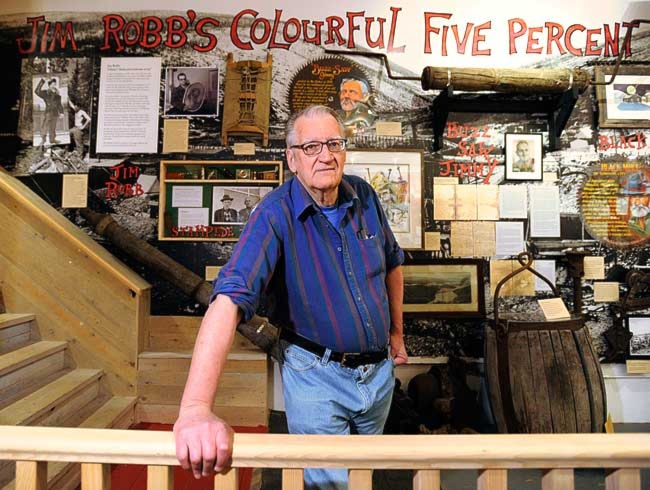Jim Robb has spent the past half-century rummaging through musty storage rooms, town dumps and garage sales, proving true that one man’s trash is another’s treasure.
In doing so, he’s “just crammed” two buildings full of odds and ends. A choice selection is on display in the basement of the MacBride Museum of Yukon History, in an exhibit that opened this week.
Robb, 77, is best known for his ink and watercolour depictions of falling-down cabins and outhouses, and for his Colourful Five Per Cent publications, which document the lives of eccentric oldtimers.
His new show, which he calls The Litter and the Glitter, augments his artwork with a range of supporting materials, from Bombay Peggy’s dress to rusted-out mining equipment.
The exhibit is animated by the same spirit as the rest of Robb’s work: he doesn’t want the Yukon to forget its roots.
“We’ve had some of the most amazing people that have walked the face of the Earth,” he said. “If we don’t remember our history, what do we have to offer?”
Robb sold his first portrait in 1957. It depicted Harry “Wig-Wam” Fieck, and Robb’s exhibit begins with a blown-up photograph of the young artist, then 24, posing with the picture.
The Whitehorse Inn purchased the painting and hung it near the entrance to its Rainbow Room lounge. So started Robb’s artistic career.
Fieck, like Robb, frequented Whitehorse’s restaurants and bars, so “you couldn’t help but meet him,” he said. The portrait shows Fieck dancing “like he was a vaudeville guy,” as he was wont to do, unprompted.
Fieck was industrious. “He could out-dig three or four young hippies by himself with a hand shovel,” said Robb.
And short-tempered. Once, he wasn’t paid promptly for a job, “so he went back that night and filled it in,” said Robb.
Next is an homage to “Buzzsaw” Jimmy Richards, who was able to saw 10 cords of wood in an hour with a contraption he built from an old tractor, a Ford Model T and scraps of iron.
He cut his own leg off. Twice.
The first accident led Richards to strap-on a wooden leg. He later fell off his machine and the saw sliced in two his prosthetic, leaving Richards unscathed.
“I fooled you that time, you sonna bitch,” Richard was reported as saying.
He died in 1967, age 94.
A portrait of Richards is painted on a buzzsaw. Beside it are a series of letters the man wrote. One, dated March 20, 1899, is posted from “Whitehorse Rapids”- written at a time when the city’s name had yet to be codified.
Robb isn’t known for his photography, but the collection includes a number of fine portraits he’s taken, as well as an interesting still life of a rubbish-ridden shelf in a cabin at Eldorado Creek.
And there’s a wide range of artifacts he’s gathered over the years.
An 1890s advertisement for the American Beer Company, painted on tin, was found in the storage room of the Westminster Hotel in Dawson City, “lying on the floor, in the dirt,” said Robb. It portrays a lion roaring alongside a beer bottle.
What looks like a large piece of cast iron sewer pipe is, in fact, part of a hydraulic monitor, used to blast pressurized water at gravel and sediment to help separate out shiny metal.
Robb found it at the dump. It’s likely from Atlin or Livingstone Creek.
A slightly charred rocking chair, also from a mine site, has been cleverly built from a wooden barrel.
There’s also a barrel and winch to hoist paydirt, wagon wheels from Forty Mile, moosehide gold pokes, an ornate cast iron stove with swirling designs, an old telephone with a wooden base, a gas lamp, a bird cage, a spittoon and much more.
There’s even an old metal bed frame that Robb salvaged in Dawson City and, until the show started, used in his own bedroom.
Along with several historic photographs of Klondike dance hall girls is a pair of kid gloves and a headband, necklace and hat pin.
Then there’s Bombay Peggy’s black silk dress, adorned with felt roses. She’s remembered as a brothel owner and bootlegger who lived in Dawson City from the 1940s until the 1960s, but Robb knew her as his landlord.
Robb sometimes worries the Yukon’s become “overrun by bureaucrats,” and that this may dilute the territory’s character. But, on this day, he’s optimistic.
He knows enough colourful youngsters. “I think we have some coming up.”
Robb’s show received $75,000 from the Canadian Northern Economic Development Agency. The funds helped pay museum staff who helped organize and display Robb’s collection.
There’s no need to hurry on down. The show continues for two years.
Contact John Thompson at
johnt@yukon-news.com.
